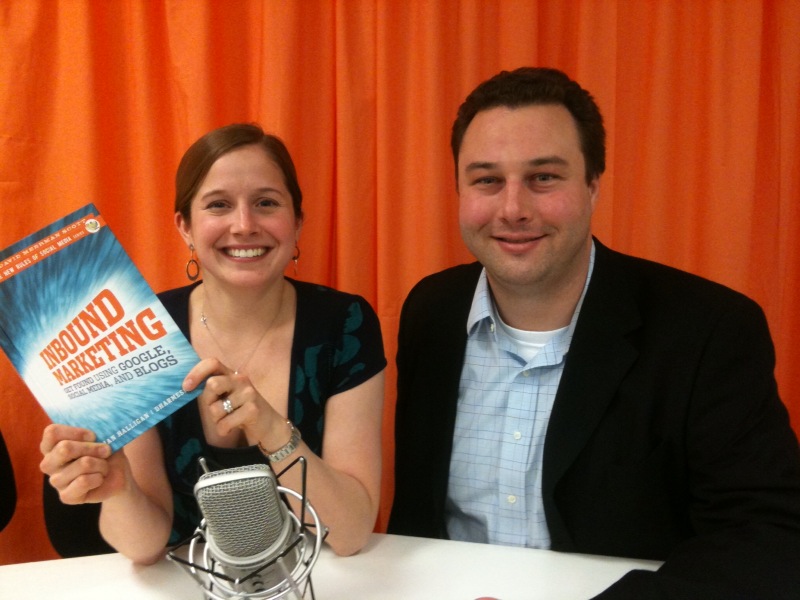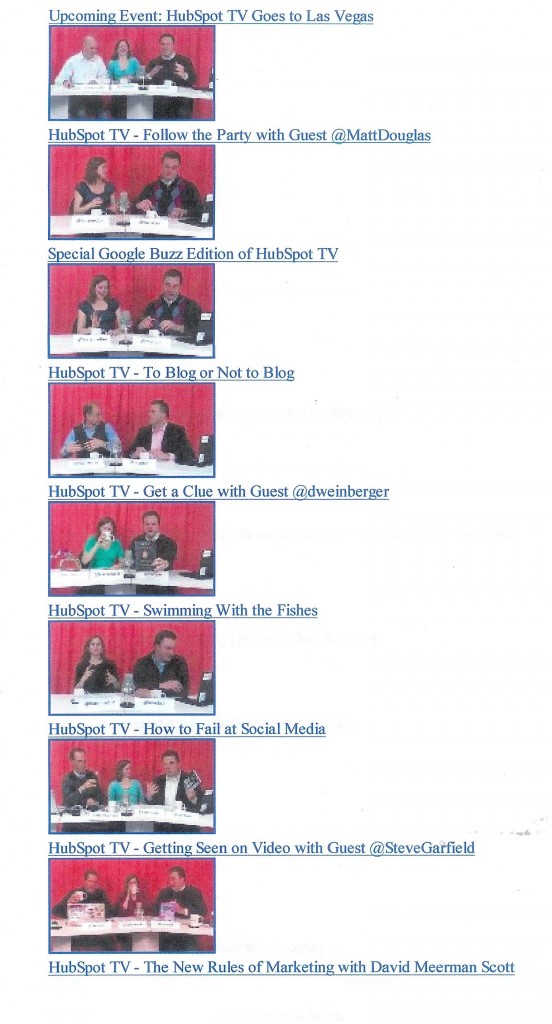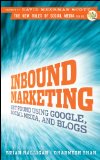Are you a HubSpot Fan?

If you are, then this article will be “speaking to the choir,” but if you don’t know anything about HubSpot AND you’re trying to learn everything Out There about Social Media, read on.
Initially, I “stumbledupon” HubSpotTV, which is a weekly Friday afternoon podcast featuring Karen Rubin and Mike Volpe, two 30-somethings who chat about social media issues of the week and often bring in social media influencers for “expert” viewpoints. You can review past segments by going to the archives on Itunes — or clicking on the thumbnails to the right.
Then I began subscribing to the HubSpot blog, which in addition to sending me a constant stream of articles like these:

The Importance of Google Page Rank: a guide for small biz execs
Marketing Budgets Shifting to Digital
Tweeting to Women, Try Entertainment; Tweeting to Men, Try Opinion
. . . and often sponsors great webinars like
State of Inbound Marketing 2010
How to use Video for Online Marketing
Finally, I’d like to recommend a recent book by HubSpot founders Brian Halligan and Dharmesh Shah — Inbound Marketing — Get Found Using Google, Social Media, and Blogs.
“We look to those in our communities for recommendations and referrals before we make purchases these days.” [authors]
The fact that industry gurus David Meerman Scott, Seth Godin, and Guy Kawasaki have recommended the book — especially in light of what we know to be true today— guaranteed me that reading Inbound Marketing would be a valuable investment of my time.
 Part of a series of books called The New Rules of Social Media, Halligan and Shah’s book offers both elementary lessons and more technical information, from —
Part of a series of books called The New Rules of Social Media, Halligan and Shah’s book offers both elementary lessons and more technical information, from —
- (A) how to grade your current website and set up a blog to
(B) building LinkedIn groups, gathering followers on Twitter to - (C) hiring “Digital Citizens” and using the right tools to make better marketing decisions.
One dozen take-aways from the book:
1) Google users search for specifics, and that is why your keywords need to be specific to increase your find-ability.
2) Your website is “1 to many” while your inbound marketing efforts are “many to many.”
3) Ten years ago, your marketing effectiveness was a function of the width of your wallet. Today, your marketing effectiveness is a function of the width of your brain.
4) The great thing about a blog article is that the page, the Google rankings, the links, and the subscriber are all durable assets — they give you value forever.
5) You have to make it easy for customers to spread the word about you.
6) The “authority” of academic papers can be determined by number of other papers that cite it. The “authority” of a web page is calculated based on teh number of inbound links from other web pages and the authority of those pages.
7) The next time you host a business event (conference, webinar, training session, etc.), use Facebook events to invite people and get RSVP’s.
8 – Use tools like Twitter Search to find influential Twitter users in your industry. Begin forging connections.
9) “Conversion” is the art and science of encouraging site visitors to further engage with your business. The true power of inbound marketing lies in its ability to not only stretch the top of your sales funnel (and pull more people in), but also to stretch the middle (get more to convert).
10) Every page on your site should have a Call To Action.
11) The idea behind lead nurturing is to maintain ongoing communication and dialog with these leads so that when they’re ready to buy, your product is at the top of their mind.
12) The good thing about inbound marketing is that everything is completely measurable.
FURTHER READING:
19 steps to getting found in social media
8 questions to ask job prospects re: their online experience